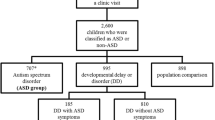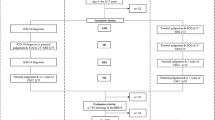Abstract
The aim of the current study was to investigate the manifestation of repetitive behaviour profiles in young children with a Pervasive Developmental Disorder. The sample consisted of 137 developmentally delayed children with a DSM-IV-TR Pervasive Developmental Disorder (PDD) and 61 developmentally delayed children without a PDD. An exploratory factor analytic investigation using 12 ADI-R repetitive behaviour items from parent report of children with a PDD reported the emergence of two factors. The first factor consisted of higher-level, “insistence on sameness” behaviours, and the second of lower-level, repetitive “sensory-motor” behaviours. This factor structure was also applicable to a more general group of young children with developmental delay, regardless of their diagnosis. Correlational analyses highlighted contrasting relationships between developmental variables and the different repetitive behaviour factors. These relationships were different for children with a PDD and those without a PDD. The findings have potential implications for the early assessment and diagnosis of PDDs in young children.
Similar content being viewed by others
References
Adrien, J. L., Lenoir, P., Martineau, J., Perrot, A., Hameury, L., Larmande, C., et al. (1993). Blind ratings of early symptoms of autism based upon family home videos. Journal of the American Academy of Child and Adolescent Psychiatry, 32, 617–626. doi:10.1097/00004583-199305000-00019.
American Psychiatric Association. (2000). Diagnostic and statistical manual of mental disorders - Text revision (4th ed.). Washington, DC: American Psychiatric Association.
Barthelemy, C., Roux, S., Adrien, J. L., Hameury, L., Guerin, P., Garreau, B., et al. (1997). Validation of the Revised Behavior Summarized Evaluation Scale. Journal of Autism and Developmental Disorders, 27, 139–153. doi:10.1023/A:1025887723360.
Bishop, S., Richler, J., & Lord, C. (2006). Association between restricted and repetitive behavior and nonverbal IQ in children with autism spectrum disorders. Child Neuropsychology, 12, 247–267. doi:10.1080/09297040600630288.
Bodfish, J. W., Lam, K. S. L., & Lewis, M. H. (2006). Empirically-derived phenotypes of repetitive behavior in autism spectrum disorders. Paper presented at the International Meeting for autism research, Montreal, Canada.
Bodfish, J. W., Symons, F. W., & Lewis, M. H. (1999). The repetitive behavior scale: Western Carolina Center Research Reports.
Bryson, S. E. (1996). Brief report: Epidemiology of autism. Journal of Autism and Developmental Disorders, 26, 165–167. doi:10.1007/BF02172005.
Carcani-Rathwell, I., Rabe-Hasketh, S., & Santosh, P. J. (2006). Repetitive and stereotyped behaviours in pervasive developmental disorders. Journal of Child Psychology and Psychiatry, and Allied Disciplines, 47, 573–581. doi:10.1111/j.1469-7610.2005.01565.x.
Chakrabarti, S., & Fombonne, E. (2001). Pervasive developmental disorders in preschool children. Journal of the American Medical Association, 285, 3093–3099. doi:10.1001/jama.285.24.3093.
Cox, A., Klein, K., Charman, T., Baird, G., Baron-Cohen, S., Swettenham, J., et al. (1999). Autism spectrum disorders at 20 and 42 months of age: Stability of clinical and ADI-R diagnosis. Journal of Child Psychology and Psychiatry, and Allied Disciplines, 40, 719–732. doi:10.1017/S002196309900400X.
Cuccaro, M. L., Shao, Y., Grubber, J., Slifer, M., Wolpert, C. M., Donnelly, S. L., et al. (2003). Factor analysis of restricted and repetitive behaviors in autism using the Autism Diagnostic Interview-R. Child Psychiatry and Human Development, 34, 3–17. doi:10.1023/A:1025321707947.
deBildt, A., Sytema, S., Ketelaars, C., Kraijer, D., Mulder, E., Volkmar, F., et al. (2004). Interrelationship between Autism Diagnostic Observation Schedule-Generic (ADOS-G), Autism Diagnostic Interview-Revised (ADI-R), and the Diagnostic and Statistical Manual of Mental Disorders (DSM-IV-TR) classification in children and adolescents with mental retardation. Journal of Autism and Developmental Disorders, 34, 129–137.
Edwards, E., Fletcher, P., Garman, M., Hughes, A., Letts, C., & Sinka, I. (1997). Reynell Developmental Language Scales III (3 ed. ed.). Windsor: NFER NELSON Publishing Company Ltd.
Freeman, B. J., Rivto, E. R., Schroth, P. C., Tonick, I., Guthrie, D., & Wake, L. (1981). Behavioral characteristics of high- and low-IQ autistic children. American Journal of Psychiatry, 138, 25–29.
Gray, K. M., & Tonge, B. J. (2001). Are there early identifying features of autism in infants and preschool children? Journal of Paediatrics and Child Health, 37, 221–226.
Hill, A., Bolte, S., Petrova, G., Beltcheva, D., Tacheva, S., & Poustka, F. (2001). Stability and interpersonal agreement of the interview-based diagnosis of autism. Psychopathology, 34, 187–191.
Honey, E., Leekam, S., Turner, M., & McConachie, H. (2006a). Repetitive behaviour in typically developing children and children with autism spectrum disorders. Journal of Autism and Developmental Disorders, 37, 1107–1115.
Honey, E., McConachie, H., Randle, V., Shearer, H., & Le Couteur, A. (2006b). One-year change in repetitive behaviours in young children with communication disorders including autism. Journal of Autism and Developmental Disorders, Published online.
Lecavalier, L., Aman, M. G., Scahill, L., McDougle, C. J., McCracken, J. T., Vitiello, B., et al. (2006). The validity of the Autism Diagnostic Interview—Revised. American Journal of Mental Retardation, 111, 199–215.
Leekam, S., Tandos, J., McConachie, H., Meins, E., Parkinson, K., Wright, C., et al. (2007). Repetitive behaviours in typically developing 2-year-olds. Journal of Children Psychology and Psychiatry, 48, 1131–1138.
Lord, C. (1995). Follow-up of two-year-olds referred for possible autism. Journal of Child Psychology and Psychiatry and Allied Disciplines, 36, 1365–1382.
Lord, C., Rutter, M., DiLavore, P. C., & Risi, S. (2003). Autism Diagnostic Observation Schedule. Los Angeles: Western Psychological Services.
Lord, C., Rutter, M., & Le Couteur, A. (1994). Autism Diagnostic Interview-Revised: A revised version of a diagnostic interview for caregivers of individuals with possible pervasive developmental disorders. Journal of Autism and Developmental Disorders, 24, 659–685.
Lord, C., Storoschuk, S., Rutter, M., & Pickles, A. (1993). Using the ADI-R to diagnose autism in preschool children. Infant Mental Health Journal, 14, 234–252.
Militerni, R., Bravaccio, C., Falco, C., Fico, C., & Palermo, M. T. (2002). Repetitive behaviors in autistic children. European Child and Adolescent Psychiatry, 11, 210–218.
Miranda-Linne, F. M., & Melin, L. (2002). A factor analytic study of the Autism Behaviour Checklist. Journal of Autism and Developmental Disorders, 32, 181–188.
Richler, J., Bishop, S. L., Kleinke, J. R., & Lord, C. (2007). Restricted and repetitive behaviors in young children with autism spectrum disorders. Journal of Autism and Developmental Disorders, 37, 73–85.
Rutter, M., Le Couteur, A., & Lord, C. (2003). Autism Diagnostic Interview Revised- WPS Edition- Manual. Los Angeles, CA: Western Psychological Services.
Schopler, E., Reichler, R. J., Bashford, A., Lansing, M. D., & Marcus, L. M. (1990). Individualized assessment and treatment for autistic and developmentally disabled children- Volume 1: Psychoeducational Profile- Revised (PEP-R). Texas: ProEd.
Shao, Y., Cuccaro, M. L., Hauser, E. R., Raiford, K. L., Menold, M. M., Wolpert, C. M., et al. (2003). Fine mapping of autistic disorder to chromosome 15q11–q13 by use of phenotypic subtypes. American Journal of Human Genetics, 72, 539–548.
Sparrow, S. S., Balla, D. A., & Cicchetti, D. V. (1984). Vineland Adaptive Behaviour Scales. Circle Pines, MN: American Guidance Services.
StataCorp. (2005). Stata statistical software: Release 9. College Station, TX: StataCorp LP.
Szatmari, P., Georgiades, S., Bryson, S., Zwaigenbaum, L., Roberts, W., Mahoney, W., et al. (2006). Investigating the structure of the restricted, repetitive behaviours and interests domain of autism. Journal of Child Psychology and Psychiatry, 47, 582–590.
Turner, M. (1996). Repetitive behaviour and cognitive functioning in autism. Unpublished PhD, University of Cambridge.
Turner, M. (1997). Towards an executive dysfunction account for repetitive behaviour in autism. In J. Russell (Ed.), Autism as an executive disorder (pp. 57–100). New York: Oxford University Press.
Turner, M. (1999). Repetitive behaviour in autism: A review of psychological research. Journal of Child Psychology and Psychiatry and Allied Disciplines, 40, 839–849.
Acknowledgments
The authors would like to thank the families who volunteered their time to participate in this study. This research was supported by grants from the Australian Research Council (ARC), National Health and Medical Research Council (NHMRC) to Dr. Gray and Professor Tonge. Authors acknowledge the Southern Health Child and Adolescent Mental Health Service—Monash Autism Program, paediatricians and Specialist Children Services in Melbourne, Australia for assisting with data collection. Thanks also to Sally Herring, Helen Madill, Daniella Ventieri and Jaclyn Lontos for their assistance with data collection.
Author information
Authors and Affiliations
Corresponding author
Rights and permissions
About this article
Cite this article
Mooney, E.L., Gray, K.M., Tonge, B.J. et al. Factor Analytic Study of Repetitive Behaviours in Young Children with Pervasive Developmental Disorders. J Autism Dev Disord 39, 765–774 (2009). https://doi.org/10.1007/s10803-008-0680-5
Received:
Accepted:
Published:
Issue Date:
DOI: https://doi.org/10.1007/s10803-008-0680-5




